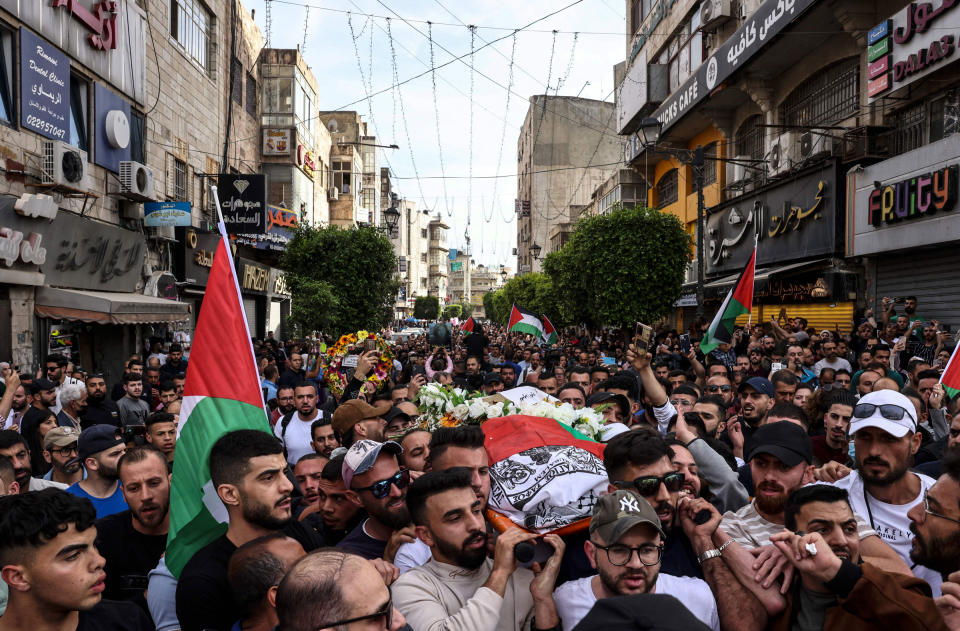The Problems With Israel's Version of the Killing of Reporter Shireen Abu Akleh

Palestinians carry the flag-draped body of veteran Al Jazeera journalist Shireen Abu Akleh as they walk toward the offices of the news channel in the West Bank city of Ramallah, on May 11, 2022. Credit - Ronaldo Schemidt—AFP/Getty Images
When word got out on Wednesday that esteemed Palestinian-American journalist Shireen Abu Akleh was killed in the West Bank city of Jenin, where Israeli forces has been making military arrest raids, Israel convened its National PR staff to form a plan of action. It decided to circulate a video of a Palestinian gunmen shooting indiscriminately from inside the Jenin refugee camp and blame them for the Al Jazeera reporter’s death. But its strategy fell flat when another video revealed that Abu Akleh died nowhere near there.
Abu Akleh was a 51-year-old Catholic Palestinian who switched to journalism after studying to be an architect and became one of the Arab world’s most famous TV journalists. Most nights for 25 years, her face lit up millions of TV screens as she shared the stories of Palestinian people living under Israeli military occupation. Arab girls and women looked up to her. And foreign journalists who reported from the Palestinian territories held her in high regard. Now Al Jazeera has accused Israel of “assassinating her in cold blood” and Arab journalists from Washington to Tunisia to Syria are staging sit-ins. Qatar lit up a building with her image. Cartoons are circulating of Abu Akleh holding a bleeding microphone with an M-16 rifle pointed at it, the type of rifle used by Israeli soldiers. A few Arab parents have named their newborn daughters ‘Shireen.’ Abu Akleh has become a Palestinian symbol.
Read More: What We Know So Far About the Killing of Al Jazeera Journalist Shireen Abu Akleh
To Israel, her death risks damage to essential relationships in the Arab world, while Abu Akleh’s U.S. citizenship brings relations with Washington into the equation, raising both the stakes and the level of scrutiny. The State Department declared ” the investigation must be immediate and thorough and those responsible must be held accountable.”
Deny and deflect is Israel’s usual strategy for dealing with high-profile civilian deaths. The deflection has come in three forms: One is claiming Palestinians killed the civilian (famous examples are British cameraman James Miller, 10-year-old Abir Aramin, the three daughters and niece of Dr. Izzeldin Abuelaish inside their home in Gaza while he begged on live television for Israel to stop firing). Often Israel claims that the victim was near a site from which Palestinian gunmen were attacking Israelis and, hence, got killed by accident by Israeli gunfire (four Gaza children on the beach, 40 people taking refuge at a U.N. school in Gaza, the British U.N. worker Iain Hook in Jenin). Israel has also claimed that the civilian was involved in an attack on Israeli soldiers or was a member of a Palestinian militant organization (photojournalist Yaser Murtaja in Gaza). In other cases, Israel said that the facts around a killing are unclear, but definitely not Israel’s fault (Palestinian family killed by shell on beach in Gaza). In the case of the 2003 death of American pro-Palestinian activist, Rachel Corrie, who was run over by a military bulldozer, the Israeli army claimed “a slab of concrete” was likely what killed her. When Israeli missiles brought down an 11-story media building last year in Gaza, where Palestinian media networks and the Associated Press were located, Israel justified it by saying it was being used by Hamas.
Back in 2006, Israeli prime minister, Ehud Olmert, initially apologized for the killings of seven members of the Ghalia family in Gaza by Israeli artillery. “But the military swiftly realised it was confronting another PR disaster to rival that of the killing of Mohammed al-Dura,” wrote Guardian journalist, Chris McGreal, referencing the wrenching footage of the Gaza boy killed cowering beside his father during a 2000 firefight. “The army quickly convened a committee to investigate the deaths on the beach and almost as swiftly absolved itself of responsibility.”
Within a half hour of Abu Akleh’s killing, the Israeli state PR machine went to work on a deflection strategy. Israeli journalist Barak Ravid revealed in a Hebrew report on Walla! website that “there was an urgent consultation of the National Hasbara (PR) Headquarters together with representatives of the Prime Minister’s Office, the Foreign Ministry and the Israeli Defense Forces. They decided that the main goal was to try and fend off the narrative that was emerging in the international media, according to which Abu Akleh was killed by Israeli fire.” (The English version of Ravid’s report on the Axios website did not include this information.) So Israel used a short video that was filmed that morning by Palestinian militants in a residential area, in which the men were heard saying that they had shot a soldier. Bennett posted the video and claimed that, since no Israeli soldier was injured in Jenin that day, the footage was evidence that the militants had mistaken Abu Akleh, in her helmet and body armor, for a combatant.

 Yahoo Autos
Yahoo Autos 